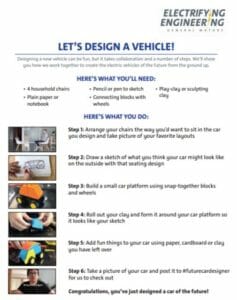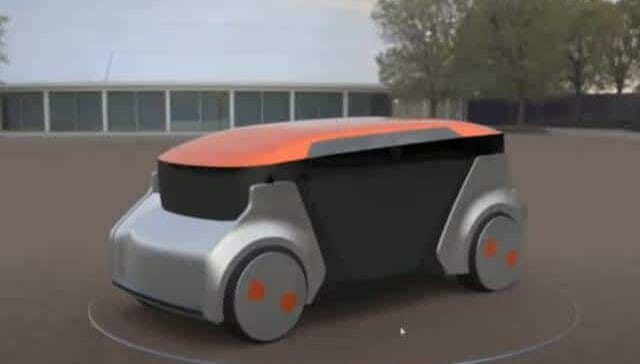STEM Resources Introduce Students to Engineering and Sustainability.
Teams from industry and academia have developed a wealth of high-quality STEM/STEAM lessons and activities to inspire and inform the next generation of engineers and sustainability experts.
General Motors released a series of videos that describe an engineering concept and lead 7- to 13-year-old learners through a hands-on activity related to the concept. For example, the video about electric motors first describes, in terms understandable to a grade-school student, how an electric motor works and lists some of its applications. Then the presenter (a GM engineer) invites his daughters on camera to play “Does it have a motor in it?” After that, the engineer demonstrates how to build a simple electric motor using a battery, a short length of wire, and a magnet. He wraps up the video by talking about his job as an engineer, designing propulsion systems for electric vehicles.
General Motors released a series of videos that describe an engineering concept and lead 7- to 13-year-old learners through a hands-on activity related to the concept. For example, the video about electric motors first describes, in terms understandable to a grade-school student, how an electric motor works and lists some of its applications. Then the presenter (a GM engineer) invites his daughters on camera to play “Does it have a motor in it?” After that, the engineer demonstrates how to build a simple electric motor using a battery, a short length of wire, and a magnet. He wraps up the video by talking about his job as an engineer, designing propulsion systems for electric vehicles.
The entire Electrifying Engineering series consists of nine videos focused on one aspect of sustainability and the engineer’s role in creating a sustainable future. Each video has a link to a sheet of instructions to build the project shown in the video.

University of Wisconsin at Stevens Point (UWSP) created the K-12 Energy Education Program (KEEP). This lesson clearinghouse is searchable by topic, grade level, activities, and other criteria. The site provides a set of fact sheets for various energy sources, activities related to energy management, and links to physical and virtual field trips. They even have several types of lab kits to lend out for hands-on work, accompanied by related lesson plans and detailed instructions for using the equipment. The Energy Audit Kit shown below includes:
- 5 wattmeters
- 5 Infrared thermometers
- 5 light meters
- 5 digital indoor thermo-hygrometers
- 5 flicker checkers
- 1 handheld thermal imaging camera
- 1 thermal imaging camera for a smartphone
- 1 battery charger for a thermal imaging camera attachment
- 1 carrying case
The Center For Renewable Energy Advanced Technological Education (CREATE) is a collaboration among three community colleges whose intent is to promote renewable energy and associated careers through faculty development workshops and business/academic partnerships. Teaching materials that faculty members develop during CREATE workshops are made available to the public through Creative Commons licenses. Most of the lessons are mapped to Next Generation Science Standards (NGSS) and/or the U.S. Department of Energy’s Energy Literacy Standards. Each lesson features a detailed instructor’s guide, an answer key, a student lesson, activity instructions, worksheets or spreadsheets (where applicable), and lists of the standards to which the lessons are mapped. Many lessons also include videos and links to additional resources.
At the basic level, students are introduced to the concept of solar energy and learn how to use a pyranometer to measure sunlight. From there, they conduct a site analysis using a Solar Pathfinder, which includes calculating a location’s solar resource month-by-month. As with most of the lab activities, students must show their calculations on the answer sheet and respond to several essay questions that involve higher levels of thinking. Those familiar with Bloom’s Taxonomy of Educational Objectives will notice that the lessons help students develop analysis, synthesis, and evaluation skills.
In addition to the Solar Pathfinder activity, students will learn to use other tools used by solar professionals, such as the National Renewable Energy Laboratory’s (NREL’s) PVWatts calculator to estimate solar production, digital multimeters to measure the voltage output of solar panels, and clamp-on meters to measure current flow. Other activities guide students through passive solar design concepts, energy auditing, and reading an electric bill. Learners will also explore higher-level concepts such as waste-to-energy and energy flow diagrams. Parents (or college students living on their own) might be happy with the lesson about reducing one’s utility bills. I wish these resources had been online when I was teaching—many of the activities are similar to projects I developed for my own classes.
Moving up the academic food chain, the University of Minnesota’s goal is for all of its campuses to be carbon-neutral by 2050. Although the school doesn’t offer a degree in renewable energy, students can select a minor in sustainability, where they’ll learn about sustainability at the individual and community levels, economic and policy factors, design and technology, bioscience, and social implications. There’s even a study abroad program. More importantly, the university encourages sustainability and practices what it preaches. For example, over a decade ago the campus’s football stadium became the first Leadership in Energy and Environmental Design (LEED) Silver certified college or professional stadium, and its newest (at the time) residence hall earned LEED certification as well. Wind turbines and solar arrays provide more than 55 million kilowatt-hours (kWh) of electricity to its campuses every year and energy efficiency initiatives have reduced the university’s annual energy consumption by more than 10 million kWh.
The university’s investment in sustainability has reduced its utility expenses by roughly $30 million dollars since 2014. Residential dining halls serve 30 tons of locally raised produce annually, reducing the carbon footprint associated with shipping goods. In 2018, the university’s waste management program prevented 417 tons of material from going to a landfill. The “ It All Adds Up ” website highlights the school’s green initiatives and provides additional sustainability resources for the general public, including a virtual sustainability tour of the campus.
The university also has a long history with solar car challenges, with its team placing fifth in the Cruiser Class during the 2019 Bridgestone World Solar Challenge.
SOURCE: engineering.com – STEM Resources to Educate the Next Generation of Engineers

